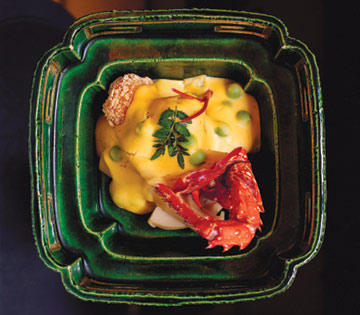
EDIBLE ART: Fried shrimp with an egg-yolk-and-green-pea sauce
(2 of 3)
After six months, Murata came back to Kyoto with a renewed sense of destiny. Rare among kaiseki's practitioners, Murata has become a Japanese food evangelist. He has appeared on countless Japanese TV shows, has written 15 books (one of which, Kaiseki, the Exquisite Cuisine of Kyoto's Kikunoi Restaurant, has just come out in English) and is chairman of the Japanese Culinary Academy. He travels the world giving cooking demonstrations, and has two women working in the kitchen of Kikunoi's Tokyo branch, plus an American and a Korean chef training at the flagship restaurant in Kyoto. Murata may embrace traditional ways, but when it comes to spreading the kaiseki gospel, he is breaking all the rules. Opening his kitchen to a temporary acolyte like me fitted perfectly with his mission.
------------------------------------------
Murata wanders through the rows of vegetables at the farm of an old friend, and plucks two fist-size eggplants. He hands me one and bites into his. I bite mine, my mouth puckering in anticipation of the bitter burst that usually accompanies raw eggplant. Instead the sun-warmed flesh is sweet and buttery, and I'm down to the stem in a few mouthfuls. Kaiseki emphasizes fresh vegetables. Long before Alice Waters sautéed her first Californian butter squash, the kaiseki chef's mantra was fresh, local and seasonal. Murata calls it "eating the seasons," and he's brought me to one of his main vegetable suppliers to illustrate the link.
Masataka Higuchi's small farm is surrounded by modern condominiums. Twenty years ago, Murata and Higuchi embarked on a program to preserve Kyoto's heirloom vegetables — tiny eggplants, sweet carrots and fragrant spring onions. Today, Murata is checking up on the tomatoes for next month's menu. He bites into one that has ripened early and closes his eyes in appreciation. Higuchi nods and hands Murata a brilliant white onion. Murata carves off a piece and chews meditatively. "Pickles," he announces, and buys 10 kg on the spot.
Murata returns to the kitchen, gathers the cooks around and passes out slices. "It is important to think beyond the week's menu," Murata lectures. "You should always be experimenting, playing." He steams the onions for a minute, then dumps them into a bowl. He douses them in a mixture of sweet rice wine vinegar and broth. Within a few moments, the onion pickles are done. They are sweet, crisp and tangy with a hint of chili pepper. Italian onions don't have a place in traditional kaiseki, but these pickles will show up with the rice at the end of today's meal. Fresh onion shavings will replace a mild Japanese ginger in a dish of simmered octopus. "If it tastes better, I'll use it," Murata says. "Tradition is something you break and rebuild at the same time. If cuisine doesn't change, it won't be alive."
But there are rules. Everything must be of the best quality, and in season. Nothing is imported. And everything must work in harmony. In western cuisine, chefs focus on bringing out solo notes and accentuating them with contrasting flavors — the bitterness of a Brussels sprout, for example, countered with the sweet smokiness of apple bacon. Japanese cuisine seeks to temper extremes and bring them into a harmonious balance. "Western chefs are conductors of large orchestras," says Murata. "Japanese cuisine is more like a violin. There are five different strings, but they are played together."
What keeps those flavors in harmony is dashi, a broth made from dried fish and seaweed. Murata calls dashi the foundation of his cooking, and he uses it in every course but dessert. It is a narrative thread, linking one dish to the next. That doesn't mean that everything tastes the same. Dashi, like salt, is a flavor enhancer. "The work of the chef is to coax out the fundamental taste that is innate to any ingredient," writes Murata in Kaiseki. With that goal, dashi helps Murata remove bitterness from a radish, tenderize octopus, or make tomato soup taste more like tomato than the tomato itself.
Murata's recipe for Kikunoi's dashi reads like a chemistry textbook. Specially aged kombu, a cold-water kelp from northern Japan, is simmered at 60� C for an hour. The kombu is removed, and the water is brought up to 80� C. Translucent pink flakes of smoked bonito, a small tuna from southern Japan, are stirred in for exactly 10 seconds (any more, and the broth takes on a bitter edge), and the resulting liquid is strained through a colander. The water must be soft. Kikunoi — which means chrysanthemum well — uses water from a 450-year-old source below the restaurant. Murata even ships the water to his restaurant in Tokyo so the dashi there is just as good. "My clients probably wouldn't be able to tell if I used poorer-quality ingredients in my dashi," says Murata. "But they would notice that my food doesn't taste as delicious."